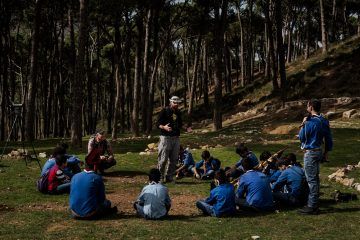Helen Sullivan in The New York Times:
 Mr. Serhal grew up in Lebanon but studied wildlife management at Oklahoma State University, graduating in 1982, at the height of the Lebanese civil war. His plan was to return and establish a hunting farm in Lebanon. But he abandoned it when, while using binoculars for the first time, he watched as a bobwhite quail hen — a game bird — ushered her chicks from bush to bush. “That gave me the shock of my life,” he said. His binoculars revealed a different way of viewing nature: “When you go to the field as a hunter with a gun, you don’t see the bird. The minute you flush it, you shoot.”
Mr. Serhal grew up in Lebanon but studied wildlife management at Oklahoma State University, graduating in 1982, at the height of the Lebanese civil war. His plan was to return and establish a hunting farm in Lebanon. But he abandoned it when, while using binoculars for the first time, he watched as a bobwhite quail hen — a game bird — ushered her chicks from bush to bush. “That gave me the shock of my life,” he said. His binoculars revealed a different way of viewing nature: “When you go to the field as a hunter with a gun, you don’t see the bird. The minute you flush it, you shoot.”
Watching the bobwhite mother protect her chicks, he thought: “I am a criminal.”
In 1990, Mr. Serhal completed a stint at the Brooklyn Zoo and, with Lebanon’s 15-year civil war ended, returned home. In 1996, he helped establish the Shouf Biosphere Reserve, Lebanon’s first national park. But after a few years, he felt the Shouf wasn’t working as well as it should. The American model, of land designated and protected by the government, had angered people in the surrounding villages, who had been free to use the area for as long as anyone could remember, to graze livestock and pick wild herbs. Mr. Serhal thought that, instead, hima might be accepted as a traditional concept; it also would include communities and municipalities in the design of the conservation areas. Hima wouldn’t be just about protecting nature, Mr. Serhal said; it would be “nature plus people.” When S.P.N.L. helped a community design a local hima, the group suggested additional conservation methods, like banning hunting. The first hima was established in southern Lebanon in 2004. Today there are 25; they have been given legal status by the government and cover more land than Lebanon’s national parks. Five of the designated hima are also what BirdLife calls “Important Bird Areas,” of which there are 15 in the country. Last year, Mr. Serhal was awarded Japan’s Midori Prize for Biodiversity, among the world’s most prestigious awards for conservation work.
More here.
